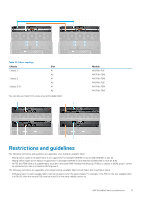Dell PowerEdge MX7000 EMC OpenManage Enterprise-Modular Edition Version 1.10.2 - Page 66
Ethernet IO Modules
 |
View all Dell PowerEdge MX7000 manuals
Add to My Manuals
Save this manual to your list of manuals |
Page 66 highlights
8 Ethernet IO Modules The MX7000 supports the following Ethernet I/O Modules (IOMs): • Managed Ethernet switches: • MX9116n Fabric Switching Engine • MX5108n Ethernet Switch • Unmanaged devices: • MX7116n Fabric Expander Module • PowerEdge MX 25Gb Ethernet Pass-Through Module • PowerEdge MX 10GBASE-T Ethernet Pass-Through Module Ethernet IOMs are supported in Fabrics A and B. For details about the supported IOM slots, see Supported slot configurations for IOMs. The Ethernet switches operate in two modes: • Full Switch mode (default) • SmartFabric Services mode or Fabric mode By default, an Ethernet switch operates in Full Switch mode. In Full Switch mode, the switch operates as a full L2/L3 switch with all functionality supported by the OS10 and the underlying hardware. The switch configuration is done through the CLI. For information about configuring a switch using the CLI, see the OS10 Enterprise Edition User Guide You can use OME-Modular to perform the following tasks: • Configure host name, SNMP, and NTP settings. • Configure port breakout modes. • Set ports up or down. • Monitor health, logs, alerts, and events. • Update and manage firmware. • View the physical topology. • Perform power control operations. It is recommended that you use the full switch mode when you require a feature or network architecture that is unavailable with SmartFabric Services. For information on Fabric mode, see SmartFabric Services. Managing Ethernet IOMs The I/O Modules page displays the health and asset information of the IOMs. If you have the fabric manager role with device configuration and power control privileges, you can perform the following tasks on the I/O Module page: • Power Cycle-Turn on, turn off, or perform a system reseat on the IOM • Update firmware, if applicable • Blink LED-Turn on or turn off the IOM Identification LED. • Refresh Inventory You must have the device configuration privileges to set up network IOMs and perform configuration tasks on them. NOTE: When a switch changes between Full Switch and Fabric modes, it reboots. NOTE: If the compute sled and fabric IOM mismatch, the health status of the compute or IOM is displayed as "Warning" in the chassis subsystem health. However, the health status is not displayed in the chassis graphical representation on the Chassis page, I/O Modules, and Compute pages. Topics: 66 Ethernet IO Modules















